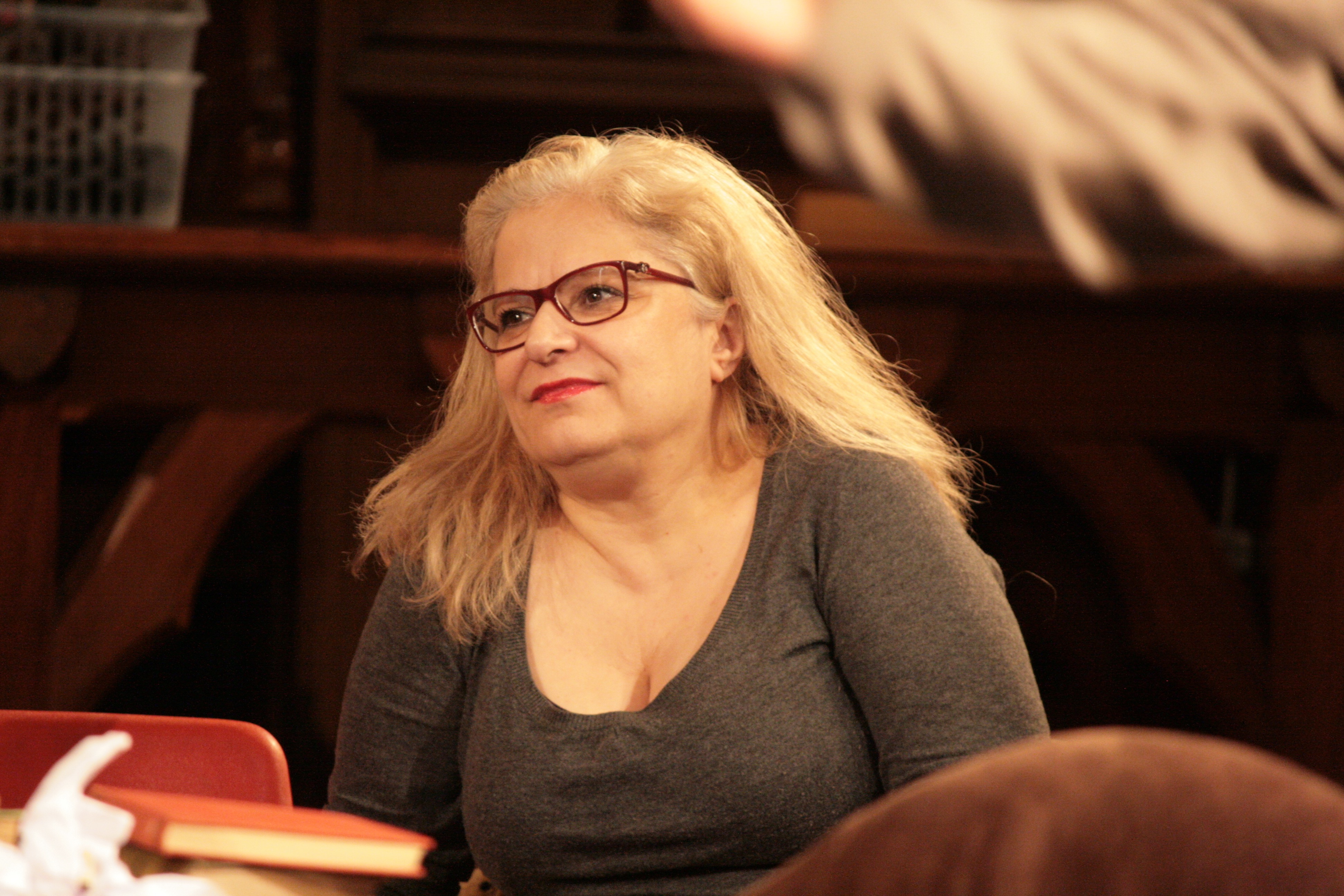Cherry Mosteshar on BBC Radio Oxford Book Club
Friday, February 3rd, 2017
I tell all our first-time authors that the best way to learn how to write a good book is to read lots of good books. Here are three of the best from 2016/17
POWER UP YOUR DIALOGUE – AND DON’T FORGET SUBTEXT
Friday, January 6th, 2017
By Pauline Kiernan
Dialogue does many things at once. Characters show what’s on their minds and who they are. It creates conflict, tension and release. Above all, dialogue is where the story’s essential core is most dramatically realised because stories are powered by characters and their actions and emotions. So first, use words that can be felt on the pulses. We need to stop thinking of words as mainly expressing reasons and ideas, or as if they belong to either our reason or our emotions, to stop making them either literal and logical on the one hand or only emotional on the other. Instead, when you’re writing dialogue think of words as thought-feelings. This helps to make sure the language has energy. There must be something moving, which impels one word to the next, one line into the next, one thought-feeling to the next. Listen to your dialogue as you write. If you leave them on the page you won’t know whether they’re going to come alive for the reader or not. Words must be a release of the inner life, and not an explanation of it or a commentary on it.
The aim is to create dialogue that prompts the reader to hear it in their head.
So the best way to create dialogue is to first say it out loud. Actors warm-up to stretch the body and free up the mind. Writers need to do this too. Spoken words vibrate in our bodies but they also vibrate in space. Moving around as we speak has a physical, emotional and mental effect on how we express meaning. This physical movement is invaluable for gaining a deep understanding of the rhythms of speech, how tone can colour and nuance emotional meaning, and how dialogue breathes. And it’s the best way I know of learning how to turn dull, flat, ‘do-nothing’ dialogue into emotional music.
Get up from your chair and walk around as you speak. Play around with some individual words and think about what ‘physical’ quality the sound suggests. Hard? Hot? Cold? Soft? Say out loud: Cut, Black, Flash, Cool, Serene, Shimmer, Power, Wash.
Think up more words and ‘test’ them on your pulses.
As you speak, taste, touch, smell, see and hear the words through all your senses (not your mind).
THE WORKOUT
When you’ve written some dialogue, get up again and move around. Speak it out loud.
Does it have energy?
Is it original?
Is it unique to the character?
Is it authentic and believable?
Does it express the uniqueness of the character?
Does it help to drive the story?
Is it foreshadowing things which come later?
Does it have resonances of what has come before?
Does it have rhythm?
Does it move?
Does it make an emotional connection with the reader?
Does it create tension?
Does it having breathing space?
Does it create conflict?
Does it pack an emotional punch?
Does it speak to the story’s theme?
Does it make the character intriguing?
Does it tantalise by making the reader want the character to say more, but he/she doesn’t?
Does it have the right tone for this moment in the story, for this character?
Does it express the right mood?
How sharp is it?
How subtle is it?
Is each word necessary?
Does it suggest the psychological state of the speaker?
Is it the right place in the story?
And…
Is it on-the-nose?
Is it dull?
Is it bland?
s it stilted?
Is it emotionless?
Is it rambling without purpose?
Does it have do-nothing words?
Is it unmotivated?
Is it over-ripe emotional?
Is it lacking in ‘personality’?
Does every character have the same way of talking?
Write short exchanges for your characters
Get one character to insult another. Go to extremes. What words are they using? Who’s ‘leading’, who’s reacting? Notice as you write what emotion lies behind the words?
Get two lovers talking. A scene of tenderness. A violent row. Making up. What are you getting them to say? Or not say?
Write a scene in which the characters are so excited that no one finishes a sentence.
Get your characters to go to a party. Write the scene to include dialogue.
Think of a party that you’ve been to. What made it interesting? How are each of the characters speaking?
A new person arrives
New information delivered that has an emotional impact on the guests
A conflict
A subtext going on
A confrontation
A meeting of strangers
A disruptive guest
A shy guest
Two people whispering
An outrageous speech by a guest. The host is looking uncomfortable. Everyone stops talking. It’s embarrassing
Hostility between two people expressed through subtext when on the surface all seems sweetness and light.
This is a terrific exercise in learning how to individualise the way your characters speak.
THE ALL-IMPORTANT SUBTEXT
Subtext is what is going on inside the characters – their inner thoughts and feelings. It’s the unspoken, the innuendo, the nuanced moments that cannot be directly represented.
It’s something understood that isn’t said.
It’s what lies beneath the words – like a river flowing beneath the words hinting at or illuminating what a character thinks and feels but does not say. It’s what lies hidden between characters under the surface of their words. It’s almost invariably the key in establishing the character’s inner life: their goals, motivation, fears. We know from what they say and do on the surface what it is they may be trying to do but it is what lies beneath that gives the reader a deeper understanding of why they’re doing what they do and say. It’s what is meant not what is said. It’s the underlying meaning or significance of a character’s words. That makes subtext a great power in writing. It’s a way to make a direct connection between the emotions of the characters with the emotional response of the reader. Think of subtext as something we read deep between the lines. It is in the gaps between that subtext lies. And they’re gaps that the reader has to fill in. Gaps that the reader will love to fill in. So subtext can do even more things than surface dialogue does. It is revealing character, showing how the character develops, revealing the deeper dynamics of relationships and forwarding the story.
Write a dialogue in which your characters have a conversation about one subject, but are really talking about something else. In other words, what are they really saying?
Here’s a very basic dialogue without subtext.
Woman: How are you?
Man: I’m fine, how are you?
Woman: Fine. And the family?
Man: The family’s very well, thank you.
This may be how we talk in everyday conversation, but it’s boring. It doesn’t tell us anything about these characters. Their speech is identical, so there is nothing to individualise them. It’s not doing anything to make the reader curious about them.
Dialogue has to intrigue the reader. So, what if we include a tiny change. A little subtext?
Woman: How are you?
Man: Fine. Yes, I’m fine. Fine.
Woman: And the family?
Man: No answer.
This sets up a question in the reader and it starts to be a beginning of a story. We
haven’t been explicitly told that there’s something wrong. The subtext has
inferred the underlying meaning underneath the words. The reader is drawn into
the moment. This is using subtext in a fairly basic example to reveal the inner
feelings of the man who cannot bring himself to express them. Subtext is terrific
for this kind of avoidance or aversion. Notice he doesn’t ask the woman how she
is. The repeated ‘Fine’ suggests he’s anything but. The response to the question
about his family is silence. Silence can speak volumes as they say.
So what has been revealed about the inner life of this character? He’s troubled,
and it seems to have something to do with his family. Even with this example,
it does begin to intrigue the reader – we want to know more.
Here’s a couple who’s marriage is falling apart, discussing which restaurant to go to. In the context of their story, the reader is being encouraged to discern what’s going on underneath their exchange.
Jill: I thought you said we were going to Bertoli’s.
John: I couldn’t have. The wine list’s abysmal. Full of pissed traders looking no older than 13. Wouldn’t know a Perignon 95 from a can of Fosters… Jill? … Did you hear me?
Jill. I was cancelling the booking.
John. Great. We’ll never get in anywhere now.
Jill. I’ll order an Indian.
John: What?
The subtext here could be hinting at or revealing several things about the characters and their relationship. It suggests that John is the dominant one in terms of the power structure in the marriage, that he feels the need to show off his knowledge even to his wife, and that perhaps beneath his mockery of young rich traders is a feeling of envy.
Jill is the passive one, can’t do anything right – and it seems that her submissive behaviour gets John even madder. It also has an element of surprise in that the reader expects that she’ll ‘fight back’ when he blames her, complaining they won’t be able to get into a restaurant now. Her line about ordering an Indian could suggest some ambiguity. It may be placatory or exactly the thing she knows will rile him!
In dialogue, answers to questions should be oblique. On-the-nose exposition, where the dialogue explains everything to the reader is a No-No.
Talk in dialogue is action and when using subtext aim more for the oblique and indirect. Is it saying too much? Is it necessary? Imagine a character wanting to say something but can’t bring him/her to say it.
Some suggestions:
Practise writing dialogue using subtext.
Notice subtext in novels and short stories you read. Look out for subtext used in films you watch. As you revise your work, mark places where you could include subtext.
See how you can evoke feeling and emotion using subtext.
Make every line work.
Avoid insignificant ‘do-nothing’ dialogue.
Finally, the writer Anthony Burgess once told a writing seminar that he always began a new novel by typing about sixty pages of dialogue – no narration, no description, just voices talking. Then, he said, he knew what the novel was about and could write it.
Hearing voices might well give you some great pointers to make your work really powerful!

Cherry Mosteshar on books
Friday, November 4th, 2016
Another link to Cherry Mosteshar, our Creative Director, talking about good books on BBC Radio Oxford
http://www.bbc.co.uk/programmes/p046dfmt
Cherry Mosteshar on books
Monday, October 31st, 2016
Our Creative Director, Cherry Mosteshar, talks great new books with David Prever on the BBC’s Oxford Book Club –
Timed out by Barbara Lorna Hudson
His Bloody Project Graeme Macrae Burnet
Sign up to our newsletter for more reviews of books by Cherry Mosteshar and many amazing guest authors.

What Women Want: Trends in Female Fiction, 2016
Monday, October 10th, 2016
By Charlotte Holloway
Trends are fickle things. What sells one year almost certainly won’t sell the next. Genres come and go – sub-genres even more so – and trying to predict them is almost impossible. Think about the success of 50 Shades of Grey. Back in January 2012 did anyone remember erotica still existed? Did anyone think it would sell? Then came April 2012 and the launch of EL James’ trilogy and suddenly erotica was all anyone wanted to read. Publishers revamped long forgotten sagas. Authors that were previously spoken about only in hushed tones were suddenly brought out and forced on book tours.
As I said, trends are fickle things, but if you want to write a bestseller, then you need to know what’s selling and jump on that wagon fast. Or, you write something utterly different and become a trendsetter. Either way, here are your current trends in women’s commercial fiction.
Tough Fiction
Perhaps as a reaction to austerity, female readers have been looking towards more introspective themes than usual. Tough subjects and strong messages are key in this genre trend, but perhaps what is more important is the punchy writing and the deep unhappiness presented through the characters. Readers want to follow the drama and be moved by the character’s journey. They want hope for the future in their fiction as much as they want it in their own lives.
The movement began some time ago with such authors as Jojo Moyes and David Nicholls, but it has grown with each passing year. Last year saw the word of mouth success The Shock of the Fall take the publishing industry by storm and this year it is the turn of Shtum by Jem Lester (Orion, April 2016) and Feeding Time by Adam Biles (Galley Beggar Press, August 2016).
Moral Dilemmas
From introspection to a reflection on society, this genre observes the darkness in the world. It helps us commit to living and experiencing despite all the negative humanity has offered us: terrorism, floods, fires, famine, and plague to name but a few. This genre brings us haunting questions and memorable characters. Zero K by Don DeLillo (Picador, May 2016) is one such novel. Through icy writing and a dazzling plot, it discusses euthanasia and cryogenics. The Noise of Time by Julian Barnes (Jonathan Cape, January 2016) is another novel that published earlier this year in this genre. His first novel since The Sense of an Ending published in 2011, this book reimagines the life of Shostakovich, detailing the composer’s torturous relationship with the Soviet authorities. It is a carefully sculpted novel that questions the fundamentals of free speech and what art can achieve.
Psychological Thrillers
The appeal of this genre lies in the suspense: the building menace from unreliable narrators and unpredictable characters keep the reader turning page after page. These novels allow the reader to peek behind the curtain into the complex psychological worlds that are marriages and friendships. They give the reader something to discuss when finished and gossiping readers create a good market for a book.
Paula Hawkins had phenomenal success last year with her psychological thriller The Girl on the Train but all she did was fill a gap created in the market by Gillian Flynn’s Gone Girl the year before. This year’s big success in this genre has been Behind Closed Doors by B.A. Paris (Harlequin, February 2016) but The Widow, a debut by Fiona Barton (Bantam Press, September 2016), is also tipped to do extremely well.
Historical
The success of TV shows such as Downton Abbey show how this genre just keeps on growing. Brought about perhaps by the speed with which the tech industry is progressing, readers want to be taken back to a different time when things were slower. They want rich, layered novels, often with multiple strands to the storyline. With several 100-year anniversaries of 1st World War battles taking place this year and the 70th anniversary of VJ day also taking place, the twentieth century offers rich pickings for good historical fiction. Devotion by Louisa Young (Borough Press, June 2016) is just one example. It portrays love and war in fascist Rome.
Readers want to be educated and this genre can do just that. A Quiet Life by Natasha Walter (Borough Press, June 2016) is inspired by Melinda Marling, the wife of Cambridge spy Donald Maclean. It’s a heart-stopping cold war thriller and a profound study of one woman’s struggle for survival.
Cutsey Cup Cake novels
This genre trend just never ends. It began with Jenny Colgan (who remains a key player) but the list of authors has widened to such names as Rosie Blake and Claire Dowling. These books are cosy and comforting at a time when so much is up in the air in real life. They are also always cheap on Kindle, so are perfect for summer holiday reading. This year’s must-have is Modern Lovers by Emma Straub (Michael Joseph, June 2016).
Adult colouring books
This is both an age- and gender-defying trend; men and women of all ages are buying colouring books in their droves. Last year, an estimated 12 million adult colouring books were sold in the US alone. Colouring book clubs are sprouting up across the globe and groups can be found on FaceBook and Instagram where members share not only their creations, but also their stories of healing. Colouring books are said to work like other mindfulness techniques such as yoga and meditation. The process of colouring has a grounding effect, slowing down the heart rate and respiration, loosening muscles, and stimulating the brain.
What this trend tells us though, is that any genre can come up at any time, blindsiding agents and making millions for savvy authors. So keep writing and keep reading because trendsetting comes from knowing your market.
(Posted by Cherry Mosteshar)






